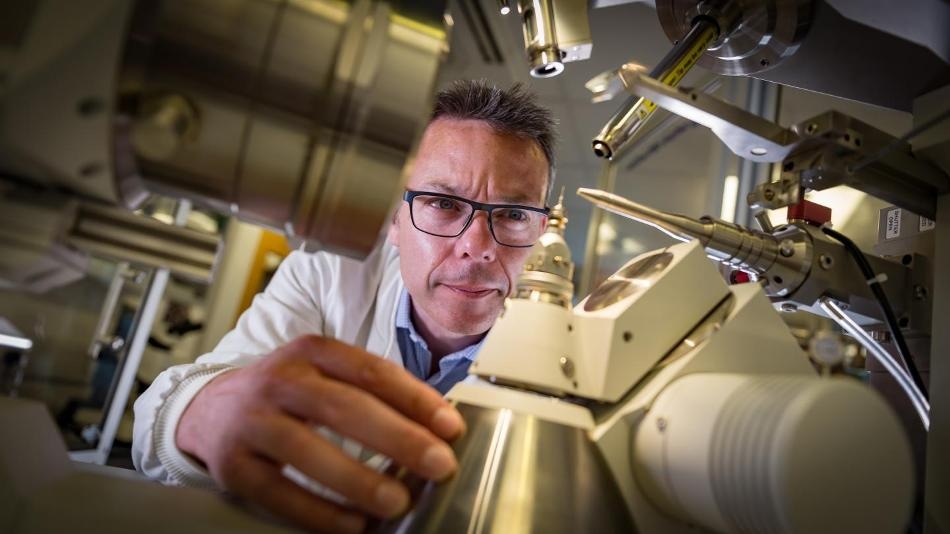Jun 25 2019
Researchers have developed a new class of enzymes to carry out one of the most significant steps during the conversion of plant waste into highly valuable and sustainable products like plastics, nylon, and chemicals.
 Professor McGeehan is the Director of the Centre for Enzyme Innovation in the School of Biological Sciences at Portsmouth. (Image credit: Stefan Venter, UPIX Photography)
Professor McGeehan is the Director of the Centre for Enzyme Innovation in the School of Biological Sciences at Portsmouth. (Image credit: Stefan Venter, UPIX Photography)
The research was conducted by scientists from the same UK-US enzyme engineering team that, in the previous year, developed and enhanced a plastic-digesting enzyme, which was a major breakthrough in plastic waste recycling.
The work has been reported in the Proceedings of the National Academy of Sciences and was led by Professor Jen Dubois from Montana State University, Dr Gregg Beckham from the US Department of Energy’s National Renewable Energy Laboratory (NREL), Professor Ken Houk from the University of California, Los Angeles in collaboration with Professor John McGeehan’s group at the University of Portsmouth.
The newly developed enzyme is active on lignin—one of the principal components of plants. For many decades, researchers have been attempting to find a method to effectively break down this component.
This is our goal—to discover enzymes from nature, bring them into our laboratories to understand how they work, then engineer them to produce new tools for the biotechnology industry. In this case, we have taken a naturally occurring enzyme and engineered it to perform a key reaction in the breakdown of one of the toughest natural plant polymers.
Professor Joan McGeehan, Director, Centre for Enzyme Innovation, School of Biological Sciences, University of Portsmouth
McGeehan continued, "To protect their sugar-containing cellulose, plants have evolved a fascinatingly complicated material called lignin that only a small selection of fungi and bacteria can tackle. However, lignin represents a vast potential source of sustainable chemicals, so if we can find a way to extract and use those building blocks, we can create great things."
In plants, lignin functions as scaffolding and is fundamental to water delivery. It strengthens and protects the plants against pathogens.
It’s an amazing material. Cellulose and lignin are among the most abundant biopolymers on earth. The success of plants is largely due to the clever mixture of these polymers to create lignocellulose, a material that is challenging to digest.
Professor Joan McGeehan, Director, Centre for Enzyme Innovation, School of Biological Sciences, University of Portsmouth
The slow breakdown process is due to the existing enzymes that appear to be active only on one of the building blocks of lignin. The researchers used sophisticated 3D structural and biochemical methods to change the shape of the enzyme to facilitate the accommodation of several building blocks. The findings led to a way of producing new materials and chemicals, like bioplastics, nylon, and carbon fiber, out of what has earlier been a waste product.
The finding also provides further environmental advantages—producing products from lignin decreases the dependency on fuel to generate conventional products and provides an appealing alternative to burning it, thereby facilitating the reduction of CO2 emissions.
The research team included leading experts in biochemistry, structural biology, synthetic biology, and quantum chemistry from the Universities of Portsmouth, Montana State, Georgia, Kentucky, and California, and two US national laboratories—Oak Ridge and NREL.
We used X-ray crystallography at the Diamond Light Source synchrotron to solve ten enzyme structures in complex with lignin building blocks. This gave us the blueprint to engineer an enzyme to work on new molecules. Our colleagues were then able to transfer the DNA code for this new enzyme into an industrial strain of bacteria, extending its capability to perform multiple reactions.
Dan Hinchen, Postgraduate Student, University of Portsmouth
In the words of Professor McGeehan, “We now have proof-of-principle that we can successfully engineer this class of enzymes to tackle some of the most challenging lignin-based molecules and we will continue to develop biological tools that can convert waste into valuable and sustainable materials.”
The work was collaboratively funded by the Biotechnology and Biological Sciences Research Council (BBSRC), National Science Foundation (NSF), and the DOE EERE Bioenergy Technologies Office. The 3D enzyme structures that constituted the basis of this study were solved at the Diamond Light Source, the UK’s national synchrotron science facility in Oxford.